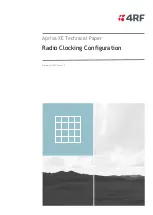
If the RTS/CTS HANDSHAKE option is turned off, the radio relies on gaps in the serial data to
determine the start and end of messages. A gap equivalent to two character periods at the serial port
baud rate is treated as a message end. The first character received after such a gap is treated as the first
character of the next message.
When RFT ROUTING mode is enabled the “NETWORK ID” and “RADIO ADDRESS” fields must be
filled out such that every radio in a system has the same network id, but a different radio address. Notes
should be kept detailing the installation of radios and their addresses.
The master station radio must be programmed with a routing table, this is accessed in the “EDIT
MODEM/INTERFACE” menu by setting “ROUTING TABLE” to “ON” and selecting “EDIT
ROUTING TABLE”. This selection leads to several pages of protocol addresses, the route by which
every protocol address is reached must then be entered, for example if the device with protocol address
37 is physically connected to the radio with radio address 23, and radio 23 is accessed from the base
station via relay radios 4 and 19, then the field entitled “ADDR 37” should be loaded with the route
“4,19,23”. If the devices with protocol addresses 65 and 93 are physically connected to radio 45 and no
relays are required then the fields entitled “ADDR 65” and “ADDR 93” should both be loaded with
“45”.
If no routing table is loaded or a protocol address cannot be found in the routing table the radio assumes
that the destination radio address is the same as the protocol address and that no relays are required.
This can be taken advantage of in simple schemes where no more than one device is connected to any
one radio.
8.3.2
POWER SAVE OPERATION WITH RFT ROUTING
When RFT ROUTING mode is enabled in the configuration programme two further fields appear
entitled “MIN PWR SAVE ADDRESS” and “MAX PWR SAVE ADDRESS”, if power save operation
is not required set both these fields to zero.
If power save operation is required it is enabled by setting the “RADIO ADDRESS” to a value greater
or equal to “MIN PWR SAVE ADDRESS” and less than or equal to “MAX PWR SAVE ADDRESS”.
The radio will then enter low power standby mode for the time programmed in the “PSAVE ON TIME”
field in the main edit menu, it will then wake up and check for an incoming signal, if none is present it
will return to sleep and repeat the cycle. If a signal is detected the radio will stay awake until a reply to
the outward bound message has been returned.
When the master station or relay radios send an outward bound message, the address of the radio to
which the message is being sent is checked against the min and max power save addresses, if a power
saved radio is indicated a cyclic wake up message is sent for the period indicated by the programmed
power save on time before the actual data message is sent, if a power saved radio is not indicated the
data message is sent immediately. These parameters along with some others are also used to calculate a
timeout time in the event that no reply is received. It is therefore essential that all radios in a system are
programmed with the same parameters even if not power saved, otherwise communications will fail.
Note that if “DTR SHUTDOWN” is enabled a radio remains completely shut down while DTR is
inactive, it will not wake up according to the power save timer to see if any incoming messages are
present. This mode should therefore only be used in conjunction with real time message scheduling.
URT500 Manual
Page 34 of 42
Rev. C – 6 August 2008









































